BBC Domesday Preservation Project
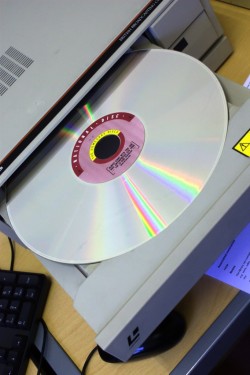 About the Domesday Project
About the Domesday ProjectWith the addition to the collection of another Acorn Domesday System, volunteers at the Centre for Computing History set about the task of preserving the precious data stored on the LVROM discs that the system uses.
We are currently taking the view that we would be publishing this content on a strictly non-profit basis and for educational use only. We are publicly requesting anyone that objects to this to contact us. We will of course respect any infringement of copyright claim and work with the claimant to remove the offending data.
Diary of Domesday Preservation Project
The first hurdle was to work out how to get the program and data files from the LVROM onto a media that could be easily ported to a PC. We knew that people had written programs to read data from LVROM and then squirt it through the RS423 serial port to a PC, but we opted to use a more modern approach!
 We purchased the external version of the RetroClinic DataCentre and connected it to the beeb. I have to say that I was extremely impressed with the quality of the product. Not only with the build, but the first class presentation and detail of the supporting documentation. The manuals were presented like the original Acorn manuals with proper wire spiral binding, in colour, and they were very well written. I can highly recommend it.
We purchased the external version of the RetroClinic DataCentre and connected it to the beeb. I have to say that I was extremely impressed with the quality of the product. Not only with the build, but the first class presentation and detail of the supporting documentation. The manuals were presented like the original Acorn manuals with proper wire spiral binding, in colour, and they were very well written. I can highly recommend it.
The one problem we encountered with the DataCentre (which was not at all a fault of the DataCentre) was the fact that it required two ROMs to operate. The first ROM effectively updated the ADFS to include the extra code to operate the DataCentre and the second RAMFS ROM offered a set of utilities. The problem was that the Domesday System software required the spare ROM sockets in the beeb to be configured as Sideways RAM meaning they were not available for the DataCentre ROMS.
Fortunately we had also bought the RetroClinic Switchable MOS which also had the updated ADFS code. So we installed the switchable MOS in place of the original MOS chip leaving the other two sockets free to be used as sideways RAM. This meant that we were unable to install the RAMFS ROM, but fortunately, for the purposes of ripping the data from the LVROM, it was not required.
The CFCARD that came with the kit also had some utilities on it. One very useful one was called "TreeCopy". It allows you to copy files between file systems, so copying the files from VFS to ADFS *should* be a fairly straight forward affair ...
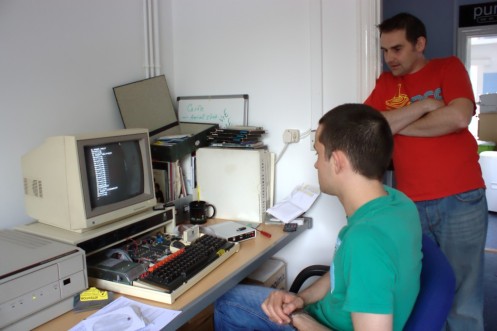
Tim Porter & Jason Fitzpatrick - In Action!
Sunday saw another busy Volunteer Day. While others worked on stuffing Amiga 1200's with loads of demoscene software, we set about extracting data from obsolete LV ROM discs!
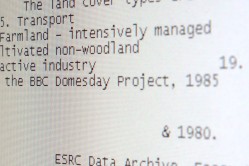 12th July 2010 - Reverse Engineering the Data
12th July 2010 - Reverse Engineering the DataTim has spent a huge amount of time looking at the raw data files contained on the LV ROMs. He has made some great break-throughs early on which is very encouraging. He has dumped a considerable amount of text from the files and worked out some of the de-limiting codes. He has also possibly worked out how the articles link to the relevant images ...
Tim has spent what must have been most of the weekend extracting data and splitting up the captured video into individual JPG images. Using some clever PHP, Tim has created an index of
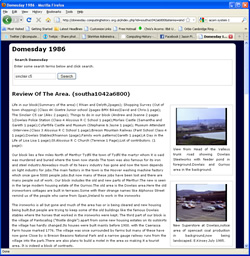 over 9600 articles from the Community Discs. Each article links to a detailed page containing text and images if present. The images folder contains over 85,000 images although some of those appear to be blank frames. There's some very interesting articles in there and the images have a lovely 1986 feel to them. It's a flat export though with no interactivity. So I guess it's now my turn to create some kind of front-end for it!
over 9600 articles from the Community Discs. Each article links to a detailed page containing text and images if present. The images folder contains over 85,000 images although some of those appear to be blank frames. There's some very interesting articles in there and the images have a lovely 1986 feel to them. It's a flat export though with no interactivity. So I guess it's now my turn to create some kind of front-end for it! Have been thinking about how to present the data from the Domesday System. Should we try to emulate the experience of using the Domesday System or simply preserve and present the data that it contained. We have a working system so anyone wanting to use the original system can do. Technology allows us to make much better use of the data now, so we probably should use that technology.
For this reason, and at this point in time, we have decided to present the data in a user-friendly way rather than try to emulate the original user interface. However, given time, we hope to include features that will show the original system in use.
4th Sept 2010 - Been Busy...
There's been quite a bit going on but not a lot to show for it. Tim has been cutting up the video files we captured from the LV discs into individual JPEG images that can then be referenced by the code we have online. There's 44,300 images for the Northern side of the Community Disc and 41,801 images for the Southern Side. Not all of them are actual images, some are blank frames from the video capture, but still... that's quite a lot of images!
We've still got to capture the video from the second side of the National Disc which is BBC news footage from 1980 to 1986...
25th Sept 2010 - Reverse Engineering Graphs
We're assembled again at the museum to crack on with the project. Alasdair has been putting a huge amount of effort into decoding the data contained on the National Disc. Specifically, he has been looking at how the data is stored for the huge number of graphs and charts contained within. Armed with his laptop of raw data and the real Domesday System he has managed to make sense of quite a lot of the data but there is still much more that remains a mystery.
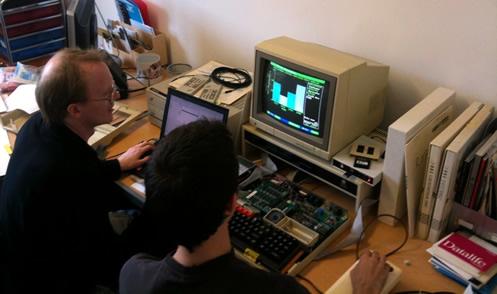
Tim & Alasdair comparing the real world events with the raw data.
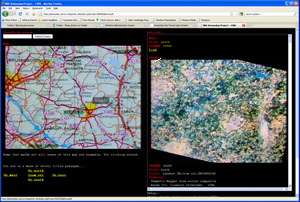
Tim has made a huge leap forward on the web interface and navigation of the maps which in turn link to the individual articles. Its still very much a debugging interface but still very useable. It's quite interesting navigating the map to specific areas to see what information it has about it...
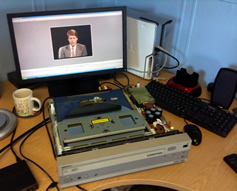 I have been busy with other aspects of running the museum, but have today captured some better quality video using a Sony Lasermax Laservision Videodisc Player (LDP-3600D). It seems to give a cleaner image with less artefacts and sparklies. We'll have the video online soon. It looks like if we want to do this in the best way we can we'll have to re-capture all the video and image frames again!!! Doh!
I have been busy with other aspects of running the museum, but have today captured some better quality video using a Sony Lasermax Laservision Videodisc Player (LDP-3600D). It seems to give a cleaner image with less artefacts and sparklies. We'll have the video online soon. It looks like if we want to do this in the best way we can we'll have to re-capture all the video and image frames again!!! Doh!While we have everything set-up we've been looking at what other Laserdiscs we have. There's some very interesting Anglia TV recordable Laservision discs, Ferranti IIS, Marconi VORAS Disc, INMERC Project, Acorn IV Robotics Disc (Including 5.25" Floppy Discs) amongst other Learn to Play Golf and general educational discs! Given time, we'll investigate these discs further...
27th September 2010 - Promo Video Online
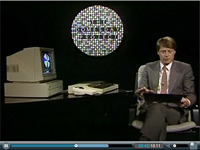 |
| Watch the Domesday System Promotional Video Presented By Nick Ross |
Click on the image on the right to watch it online ...
5th April 2010 - Walk Throughs Cracked
Tim and Alasdair have now cracked the way the walk-throughs work on the community disc. We have a basic interface working online - we just need to make the UI more attractive.
18th April 2010 - On Display at Gadget Show Live
We had one of our real working Domesday Systems on display at the Gadget Show Live. It generated a lot of interest and prompted a number of people to get in touch with us regarding the project. We demonstrated the online system as it currently stands.
Good Pictures : Tim Porter, Poor Pictures : Jason Fitzpatrick






















